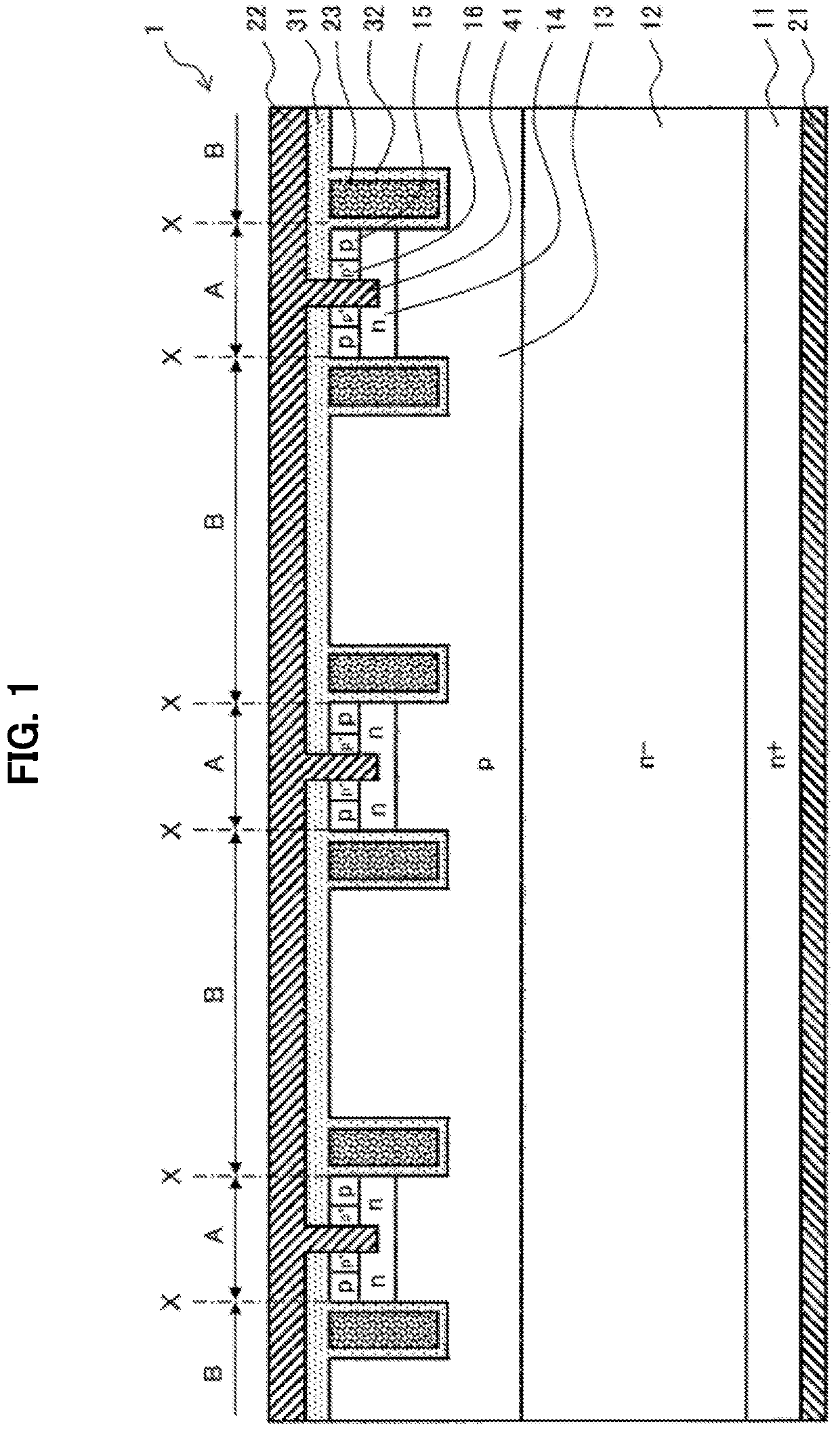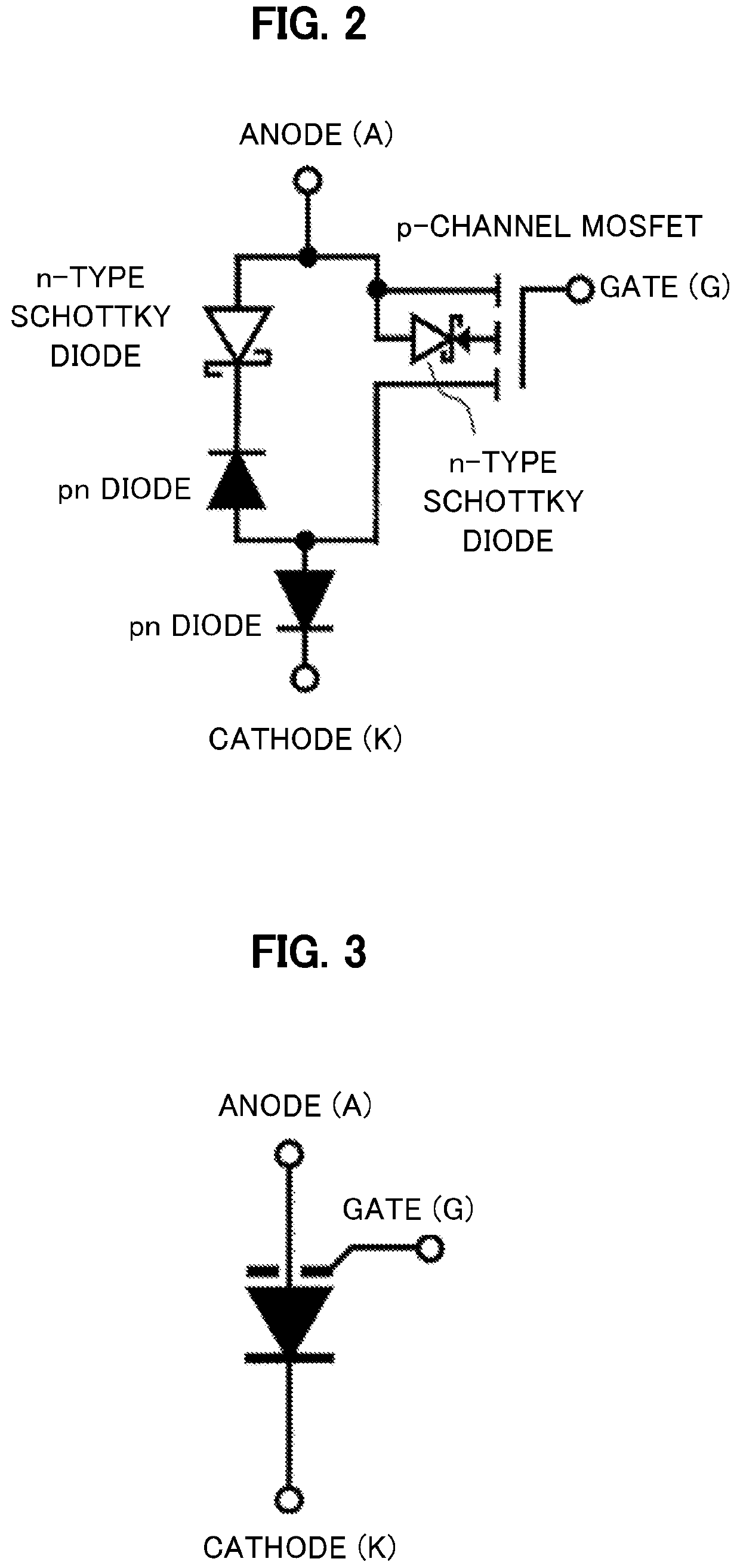Semiconductor device and power conversion device
a technology of a power conversion device and a semiconductor, which is applied in the direction of semiconductor devices, basic electric elements, electrical appliances, etc., can solve the urgent and important problem of reducing the power loss of the power conversion device, and achieve the effect of preventing a decrease in the voltage resistance, reducing the forward voltage drop and the backward recovery curren
- Summary
- Abstract
- Description
- Claims
- Application Information
AI Technical Summary
Benefits of technology
Problems solved by technology
Method used
Image
Examples
first embodiment
[0047]FIG. 1 is a diagram showing an example of a cross-sectional structure of a semiconductor device 1 according to a first embodiment of the invention. As shown in FIG. 1, a semiconductor substrate of the semiconductor device 1 includes an n+ layer 11, an n− layer 12, a p layer 13, an n layer 14, a p layer 15, and a p+ layer 16. A cathode electrode 21 is in electrical contact with the n+ layer 11 at a low resistance. On the other hand, on a side of an anode electrode 22, the p+ layer is provided in the p layer 15, and at least a part of the p+ layer 16 is in contact with the anode electrode 22 at a low resistance. In addition, a Schottky junction is formed between the anode electrode 22 and the n layer 14.
[0048]A gate electrode 23 having a trench structure is insulated from the semiconductor substrate and the anode electrode 22 via a gate insulating film 32 and an insulating film 31. A side of the semiconductor substrate of the gate insulating film 32 is surrounded by the p layer ...
second embodiment
[0072]FIG. 10 is a diagram showing an example of a cross-sectional structure of the semiconductor device 2 according to a second embodiment of the invention. The semiconductor device 2 according to the second embodiment and the semiconductor device 1 according to the first embodiment are different depending on whether the gate electrode 23 is in contact with one side surface or both side surfaces of the semiconductor substrate. That is, in the semiconductor device 1 shown in FIG. 1, both side surfaces of the gate electrode 23 are in contact with the semiconductor substrate (the p layer 13, the n layer 14, and the p+ layer 16) via the gate insulating film 32. In contrast, in the semiconductor device 1 according to the present embodiment, one side surface of the gate electrode 23 is in contact with the semiconductor substrate (the p layer 13, the n layer 14, and the p+ layer 16) via the gate insulating film 32, and another side surface is in contact with a thick insulating film 31. In...
third embodiment
[0074]FIG. 11 is a diagram showing an example of a cross-sectional structure of a semiconductor device 3 according to a third embodiment of the invention. The semiconductor device 3 according to the third embodiment differs from the semiconductor device 1 according to the first embodiment (see FIG. 1) in that the semiconductor device 3 has a planar structure in which the gate electrode 23 is provided on the surface of the semiconductor substrate. The semiconductor device 3 having the planar structure has an effect that a manufacturing process is easy since it is not necessary to dig a trench in the semiconductor substrate. The other effects are substantially the same as those of the first embodiment.
PUM
| Property | Measurement | Unit |
|---|---|---|
| voltage | aaaaa | aaaaa |
| gate voltage | aaaaa | aaaaa |
| gate voltage | aaaaa | aaaaa |
Abstract
Description
Claims
Application Information
 Login to View More
Login to View More - R&D
- Intellectual Property
- Life Sciences
- Materials
- Tech Scout
- Unparalleled Data Quality
- Higher Quality Content
- 60% Fewer Hallucinations
Browse by: Latest US Patents, China's latest patents, Technical Efficacy Thesaurus, Application Domain, Technology Topic, Popular Technical Reports.
© 2025 PatSnap. All rights reserved.Legal|Privacy policy|Modern Slavery Act Transparency Statement|Sitemap|About US| Contact US: help@patsnap.com



